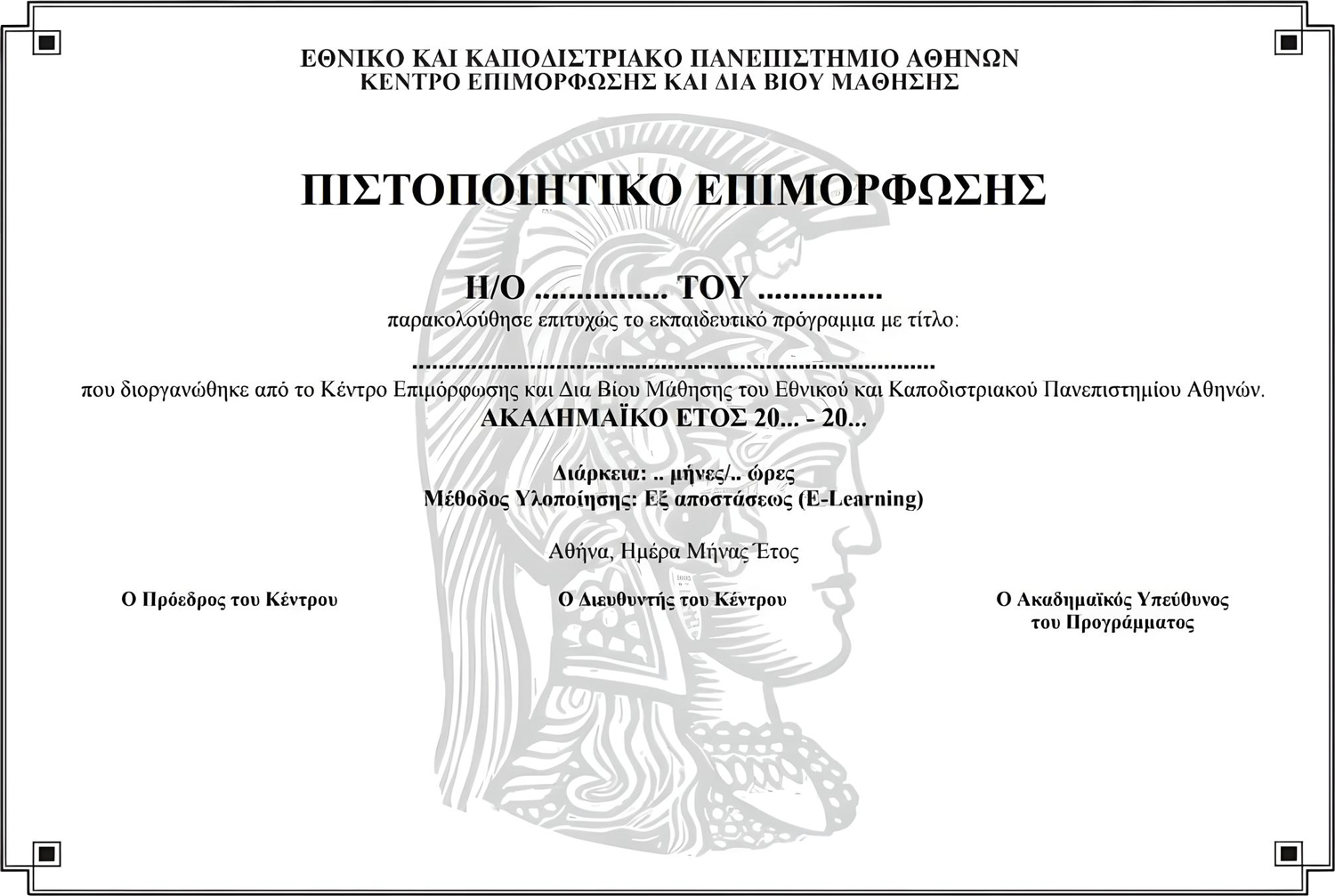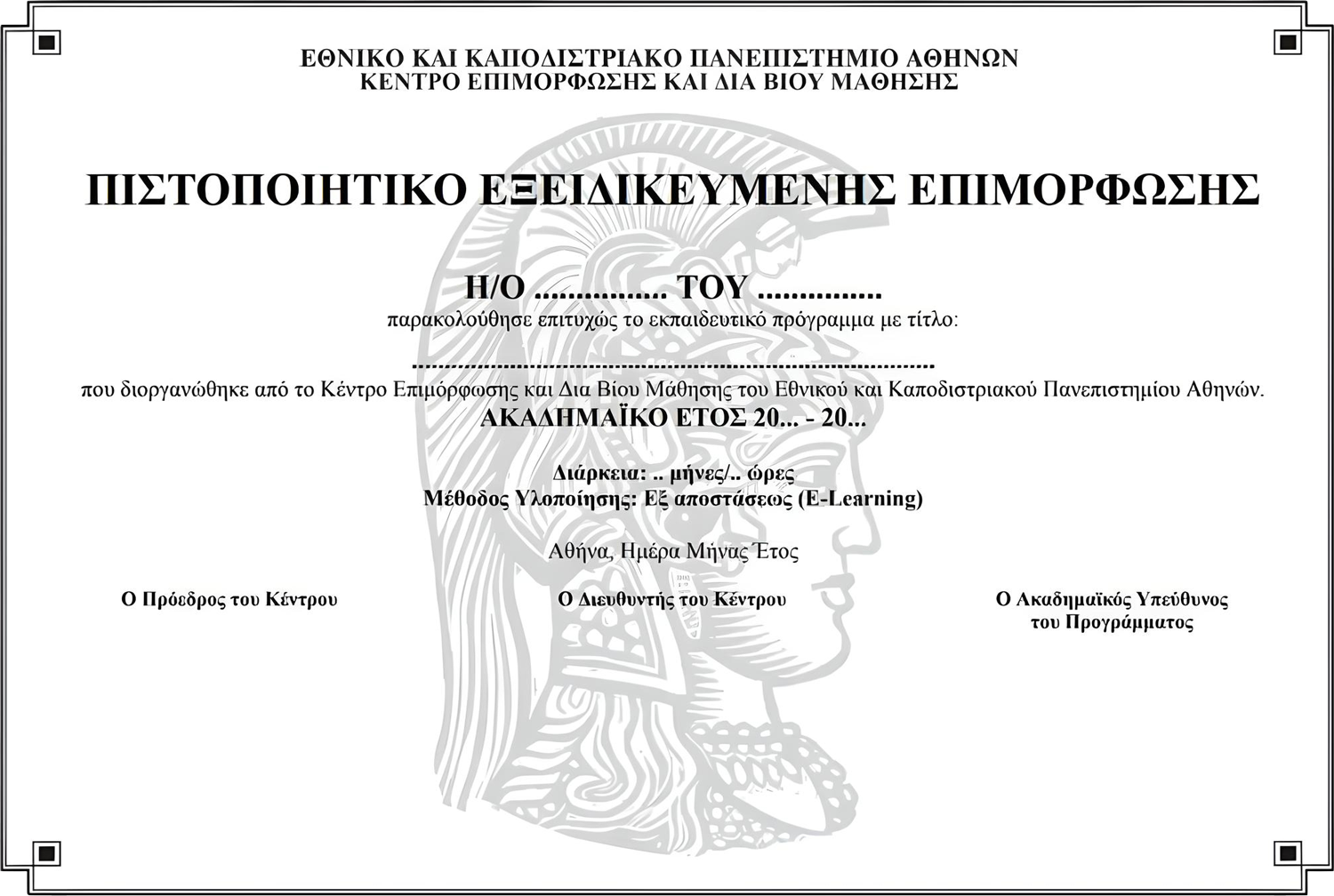Banking, Accounting and Finance
-5% for Early Entry until 8/1/2025
Application until 27 Jan. 2025

-
Mode of Study
Distance Learning
-
Duration
5 Months
-
Credits
16 ECVET
-
Tuition Fees
600€ (without discount)
Program Objectives
The “Banking, Accounting, and Finance” program aims to provide theoretical and practical training to participants in the fields of banking, accounting, and finance, enabling them to enhance and update their knowledge in these areas.
Additionally, the program seeks to empower participants in utilizing financial tools to make effective decisions.
Participants will become familiar with capital cost calculations, investment program evaluation, application of modern portfolio theory, and analysis of financial statements.
Furthermore, the program will cover different types of banking and their respective functions, the concept of banking regulation, and various types of banking risks.
The comprehensive design of the program promotes a holistic understanding of these subjects while incorporating applied knowledge that can be immediately utilized in the workplace.
Training Cycle Calendar
-
27/1/2025
Application Deadline
-
30/2/2025
Program Start Date
-
4/2025
Certificate Award
During Christmas, Easter, and the month of August, the Executive Program is temporarily suspended.
Who Should Attend
The program is designed for:
- Business and organization executives who aspire to acquire the necessary banking, accounting, and financial knowledge and skills required for future professional growth and success.
- Professionals seeking to accelerate their career advancement in their current roles.
- Individuals looking to transition to a new job position or company.
- Entrepreneurs and professionals who wish to gain the financial tools needed to implement their business plans.
Skills You Will Gain
Through the Executive Program in Banking, Accounting, and Finance, participants will benefit in multiple ways. Graduates of the program will be able to:
Explain the transformation functions performed by banks.
Define the concepts of adverse selection and moral hazard.
Identify the main types of risks faced by banks.
Explain the key concepts of capital cost calculation for businesses.
Apply the most important methods for evaluating investment programs.
Describe the Capital Asset Pricing Model (CAPM).
Explain the concept and importance of accounting.
Identify the components of financial statements.
Describe horizontal (time-series) analysis.
Describe vertical (common-size) analysis.
Course Modules
Total Duration: 5 Months Teaching Hours: 400
Introduction to Banking, Accounting, and Finance
2 WeeksAccounting information and decision-making
Financial system
Role of banks
Asymmetric information
Cost of Capital
2 WeeksTime value of money
Basic concepts of a company’s cost of capital
Cost of bond financing
Cost of equity
Weighted average cost of capital
Investment Evaluation
2 WeeksMethods for evaluating investment programs
Payback period method
Net present value (NPV) method
Internal rate of return (IRR) method
Modified internal rate of return (MIRR) method
Modern Portfolio Theory
2 WeeksReturn and risk
Expected return and portfolio risk
Efficient portfolios
Single-index model
Systematic and unsystematic risk
Capital asset pricing model (CAPM)
Presentation of Financial Statements
2 WeeksAccounts and financial statements
Balance sheet
Income statement
Cash flow statement
Double-Entry System and Accounting Records
2 WeeksAccounting transactions and financial records
Accounting equation
Double-entry system and accounting books
Accounting cycle
Financial Statement Analysis and Break-Even Point
2 WeeksTypes of financial statement analysis
Horizontal (time-series) analysis
Vertical (common-size) analysis
Common-size statements
Trend ratios
Introduction to financial ratios
Break-even analysis
Key Characteristics of Banks
2 WeeksBanking services
Types of banking
Central banking
Bank balance sheets
Banking Regulation and Supervision
2 WeeksTypes of regulation
Financial safety net
Regulatory constraints
Basel Committee
Banking Risks
2 WeeksMain types of risk
Credit risk
Interest rate risk
Liquidity risk
Other risks
Discount Categories
-
Category A – 10% Discount
Unemployed individuals
Persons with disabilities
Employees of universities and research centers
Groups of three or more participants from the same organization
-
Category B – 5% Discount
Early registration up to one month before the application deadline
Full tuition payment before the program start date
Please note that the above discount categories cannot be combined. If a participant qualifies for both categories, only the higher discount will be applied.
Certificate
Successful completion of the program leads to the award of a certificate, which includes the program title and the exact number of training hours. Depending on the program, the awarded certificate may be:
Europass / ECVET Certificate Supplement
The Europass / ECVET Certificate Supplement is a document that accompanies the training or specialized training certificate awarded upon program completion.
It provides a detailed description of the training program, including the course modules, duration, admission requirements, assessment process, learning outcomes, and the skills and competencies acquired.
It enhances the value of the awarded training or specialized training certificate and can be used by graduates for employment opportunities, career advancement, or further studies.
Methodology
-
Training Method
Distance learning (e-learning) through an interactive platform.
-
Platform Features
User-friendly, includes e-books, interactive content, multimedia, self-assessment, and livestreaming.
-
Structure
Learning modules with study guidelines.
-
Content
Objectives, outcomes, keywords, introduction, main text, examples, case studies, exercises, audiovisual material, slides, summary.
-
Support
Continuous communication and livestream meetings with instructors.
-
Assessment
Self-assessment, exercises, and final evaluation with multiple-choice questions and the option for retaking.
Contact
-
210 368 9430
Executive Programs Secretariat, Monday to Friday (11:00 – 17:00)
-
executive-programs@econ.uoa.gr
Contact via email
-
Sofokleous 1 Street
Executive Programs Secretariat, Monday to Friday, 11:00 – 17:00, at Grypareion Megaron, Sofokleous 1, 5th floor, Office 518, Athens, Postal Code 10559


